奥运会比赛规则英文版
- 格式:docx
- 大小:21.20 KB
- 文档页数:17
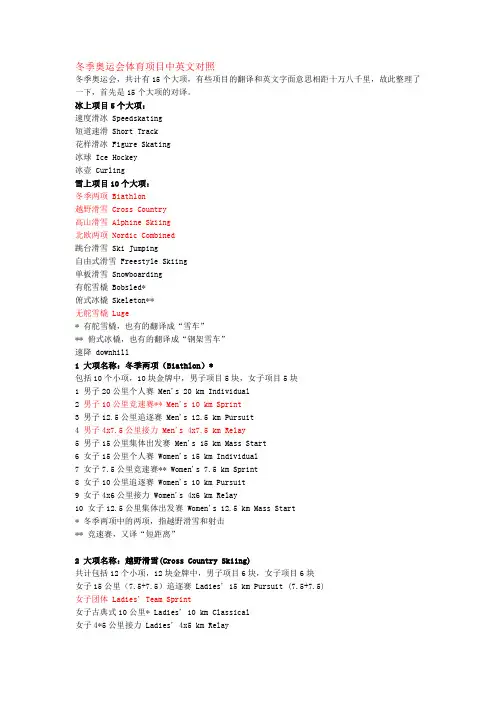
冬季奥运会体育项目中英文对照冬季奥运会,共计有15个大项,有些项目的翻译和英文字面意思相距十万八千里,故此整理了一下,首先是15个大项的对译。
冰上项目5个大项:速度滑冰 Speedskating短道速滑 Short Track花样滑冰 Figure Skating冰球 Ice Hockey冰壶 Curling雪上项目10个大项:冬季两项 Biathlon越野滑雪 Cross Country高山滑雪 Alphine Skiing北欧两项 Nordic Combined跳台滑雪 Ski Jumping自由式滑雪 Freestyle Skiing单板滑雪 Snowboarding有舵雪橇 Bobsled*俯式冰橇 Skeleton**无舵雪橇 Luge* 有舵雪橇,也有的翻译成“雪车”** 俯式冰橇,也有的翻译成“钢架雪车”速降 downhill1 大项名称:冬季两项(Biathlon)*包括10个小项,10块金牌中,男子项目5块,女子项目5块1 男子20公里个人赛 Men's 20 km Individual2 男子10公里竞速赛** Men's 10 km Sprint3 男子12.5公里追逐赛 Men's 12.5 km Pursuit4 男子4x7.5公里接力 Men's 4x7.5 km Relay5 男子15公里集体出发赛 Men's 15 km Mass Start6 女子15公里个人赛 Women's 15 km Individual7 女子7.5公里竞速赛** Women's 7.5 km Sprint8 女子10公里追逐赛 Women's 10 km Pursuit9 女子4x6公里接力 Women's 4x6 km Relay10 女子12.5公里集体出发赛 Women's 12.5 km Mass Start* 冬季两项中的两项,指越野滑雪和射击** 竞速赛,又译“短距离”2 大项名称:越野滑雪(Cross Country Skiing)共计包括12个小项,12块金牌中,男子项目6块,女子项目6块女子15公里(7.5+7.5)追逐赛 Ladies' 15 km Pursuit (7.5+7.5)女子团体 Ladies' Team Sprint女子古典式10公里* Ladies' 10 km Classical女子4*5公里接力 Ladies' 4x5 km Relay女子竞速赛** Ladies' Sprint女子30公里自由式集体出发 Ladies' 30 km Free, Mass start男子30公里(15+15)追逐赛 Men's 30 km Pursuit (15+15)男子团体 Men's Team Sprint男子古典式15公里* Men's 15 km Classical男子4*10公里接力 Men's 4x10 km Relay男子竞速赛** Men's Sprint男子50公里自由式集体出发 Men's 50 km Free, Mass start*古典式,又译“传统技术”**竞速赛,又译“短距离”3 大项名称:冰壶Curling包括2个小项,2块金牌中,男子项目1块,女子项目1块。
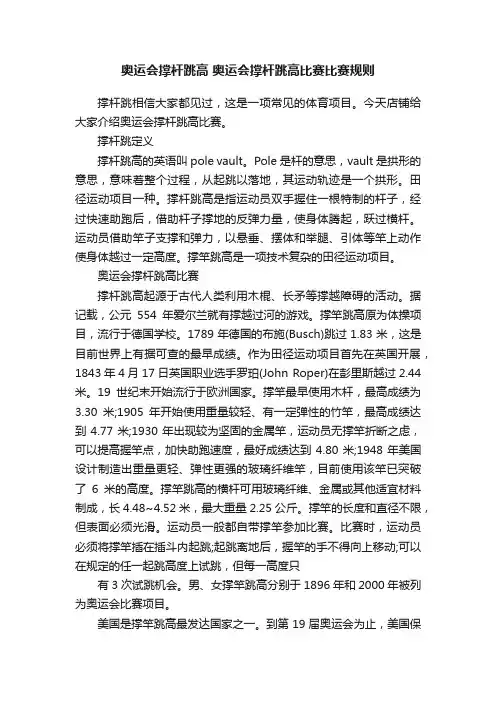
奥运会撑杆跳高奥运会撑杆跳高比赛比赛规则撑杆跳相信大家都见过,这是一项常见的体育项目。
今天店铺给大家介绍奥运会撑杆跳高比赛。
撑杆跳定义撑杆跳高的英语叫pole vault。
Pole是杆的意思,vault是拱形的意思,意味着整个过程,从起跳以落地,其运动轨迹是一个拱形。
田径运动项目一种。
撑杆跳高是指运动员双手握住一根特制的杆子,经过快速助跑后,借助杆子撑地的反弹力量,使身体腾起,跃过横杆。
运动员借助竿子支撑和弹力,以悬垂、摆体和举腿、引体等竿上动作使身体越过一定高度。
撑竿跳高是一项技术复杂的田径运动项目。
奥运会撑杆跳高比赛撑杆跳高起源于古代人类利用木棍、长矛等撑越障碍的活动。
据记载,公元554年爱尔兰就有撑越过河的游戏。
撑竿跳高原为体操项目,流行于德国学校。
1789年德国的布施(Busch)跳过1.83米,这是目前世界上有据可查的最早成绩。
作为田径运动项目首先在英国开展,1843年4月17日英国职业选手罗珀(John Roper)在彭里斯越过2.44米。
19世纪末开始流行于欧洲国家。
撑竿最早使用木杆,最高成绩为3.30米;1905年开始使用重量较轻、有一定弹性的竹竿,最高成绩达到4.77米;1930年出现较为坚固的金属竿,运动员无撑竿折断之虑,可以提高握竿点,加快助跑速度,最好成绩达到4.80米;1948年美国设计制造出重量更轻、弹性更强的玻璃纤维竿,目前使用该竿已突破了6米的高度。
撑竿跳高的横杆可用玻璃纤维、金属或其他适宜材料制成,长4.48~4.52米,最大重量2.25公斤。
撑竿的长度和直径不限,但表面必须光滑。
运动员一般都自带撑竿参加比赛。
比赛时,运动员必须将撑竿插在插斗内起跳;起跳离地后,握竿的手不得向上移动;可以在规定的任一起跳高度上试跳,但每一高度只有3次试跳机会。
男、女撑竿跳高分别于1896年和2000年被列为奥运会比赛项目。
美国是撑竿跳高最发达国家之一。
到第19届奥运会为止,美国保持了历届奥运会撑竿跳高的冠军。

--Men's 10m Platform男子10米跳台 --Women's Taekwondo Over 67kg女子67公斤级以上跆拳道--Women's Athletics 20km Walk女子20公里竟走--Men's Diving Synchronized 3m Springboard男子3米跳板--Women's Diving 3m Springboard女子3米跳板--Women's Diving Synchronized 10m Platform女子10米跳台--Men's Wrestling GrecoRoman 58kg男子58公斤古典摔交--Men's Diving 3m Springboard男子3米跳板--Men's Artistic Gymnastics Parallel Bars竞技体操男子双杠--Women's Artistic Gymnastics Beam竞技体操女子自由体操--Men's Table Tennis Singles男子乒乓单打 --Women's Diving 10m Platform女子10米跳台--Women's Artistic Gymnastics Uneven Bars竞技体操女子跳马 --Women's Table Tennis Singles女子乒乓单打--Men's Badminton Singles男子羽毛球单打--Women's Badminton Doubles女子羽毛球双打 --Men's Diving Synchronized 10m Platform跳水男子10米跳台--Women's Diving Synchronized 3m Springboard 跳水女子3米跳板--Men's Table Tennis Doubles男子乒乓球双打 --Women's Badminton Singles女子羽毛球单打--Men's Fencing Team Foil击剑男子团体花剑--Women's Judo Heavyweight +78kg柔道女子重量级78公斤--Men's Shooting 10m Running Target射击男子10米移动靶 --Women's Shooting 25m Pistol射击女子25米运动手枪--Women's Table Tennis Doubles女子乒乓球双打--Men's Weightlifting 77kg举重男子77公斤级抓举 --Women's Weightlifting 75+ kg举重女子75公斤以上级抓举Mixed Badminton Doubles羽毛球男子双打--Women's Artistic Gymnastics AllAround Finals 竞技体操女子个人全能决赛--Women's Judo HalfHeavywt 78kg女子次重量级78公斤级柔道--Men's Artistic Gymnastics AllAround Finals竞技体操男子个人全能--Women's Fencing Team Epee击剑女子团体重剑--Women's Artistic Gymnastics Team Finals竞技体操女子团体 --Women's Judo HalfMiddlewt 63kg女子次中量级63公斤级柔道·--Women's Weightlifting 63kg女子63公斤级挺举举重--Women's Weightlifting 69kg女子69公斤级抓举举重--Men's Artistic Gymnastics Team Finals 男子团体竞技体操--Men's Shooting 10m Air Rifle射击男子10米气步枪--Women's Shooting Trap射击女子多向飞碟--Women's Weightlifting 53kg举重女子53公斤级抓举--Women's Judo HalfLightwt 52kg女子次轻量级52公斤柔道--Women's Shooting 10m Air Pistol女子10米汽枪--Women's Cycling Track 500m Time Trial 运动场自行车赛女子500米计时赛--Men's Shooting 10m Air Pistol男子10米气手枪--Women's Shooting 10m Air Rifle女子10米气步枪--Men's Weightliftingacrobatic gymnastics 技巧运动 athletics/track & field 田径 beach 海滩 boat race 赛艇 bobsleigh, bobsled 雪橇 boxing 拳击 canoe slalom 激流划船 canoe 赛艇 chess 象棋 cricket 板球 cycling 自行车 diving 跳水 downhill race 速降滑雪赛,滑降 dragonboat racing 赛龙船 dressage 盛装舞步 equestrian 骑马 fencing 击剑 figure skating 花样滑冰 football(英语)/soccer (美语)足球 freestyle 自由式 gliding; sailplaning 滑翔运动 golf 高尔夫球 GreeceRoman wrestling 古典式摔跤 gymnastic apparatus 体操器械 gymnastics 体操 handball 手球 hockey 曲棍球 hold, lock 揪钮 horizontal bar 单杠 hurdles; hurdle race 跨栏比赛 huttlecock kicking 踢毽子 ice skating 滑冰 indoor 室内 item Archery 箭术 judo 柔道 jumping 障碍 kayak 皮划艇 mat exercises 垫上运动 modern pentathlon 现代五项运动 mountain bike 山地车 parallel bars 双杠 polo 马球 qigong; breathing exercises 气功 relative work 造型跳伞 relay race; relay 接力 rings 吊环 roller skating 滑旱冰 rowing 划船 rugby 橄榄球 sailing 帆船 shooting射击 side horse, pommelled horse 鞍马 ski jump 跳高滑雪 ski jumping competition 跳高滑雪比赛 ski 滑雪板 skiing 滑雪 slalom 障碍滑雪 softball 垒球 surfing 冲浪 swimming 游泳 table tennis 乒乓球 taekwondo 跆拳道 tennis 网球 toxophily 射箭 track 赛道 trampoline 蹦床 trapeze 秋千 triathlon 铁人三项 tugofwar 拔河 volleyball 排球 badminton 羽毛球 baseball 棒球 basketball 篮球 walking; walking race 竞走 wall bars 肋木 water polo 水球 weightlifting 举重 weights 重量级 winter sports 冬季运动 wrestling 摔交 yacht 游。
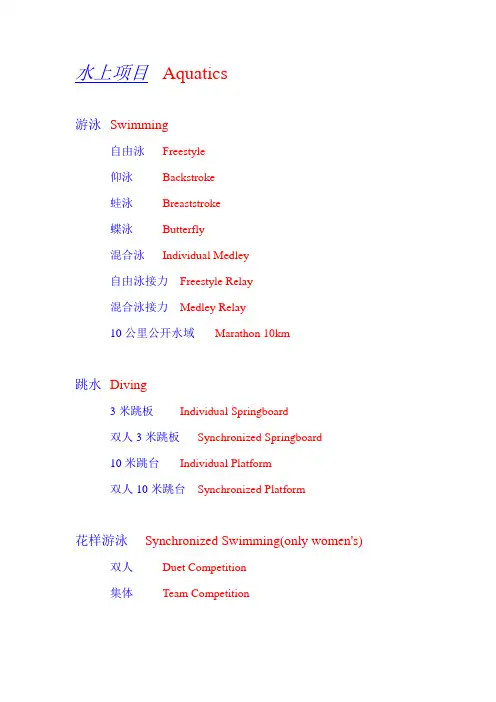
水上项目Aquatics游泳Swimming自由泳Freestyle仰泳Backstroke蛙泳Breaststroke蝶泳Butterfly混合泳Individual Medley自由泳接力Freestyle Relay混合泳接力Medley Relay10公里公开水域Marathon 10km跳水Diving3米跳板Individual Springboard双人3米跳板Synchronized Springboard10米跳台Individual Platform双人10米跳台Synchronized Platform花样游泳Synchronized Swimming(only women's) 双人Duet Competition集体Team Competition水球Water Polo男子Men女子Women射箭Archery奥林匹克淘汰赛个人赛Individual Competition 奥林匹克淘汰赛团体赛Team Competition田径Track & Field110米栏110m Hurdles3000米障碍3000m Steeplechase20公里竞走20km Race Walk4×100米接力4×100m Relay马拉松Marathon跳高High Jump跳远Long Jump三级跳远Triple Jump撑竿跳高Pole Vault铅球Shot Put铁饼Discus Throw标枪Javelin Throw链球Hammer Throw男子十项全能Men's Decathlon女子七项全能Women's Heptathlon羽毛球Badminton单打Singles双打Doubles混合双打Mixed Doubles棒球Baseball篮球Basketball拳击Boxing男子-48公斤级Men's Light Fly Weight 男子48-51公斤级Men's Fly Weight男子51-54公斤级Men's Bantam Weight 男子54-57公斤级Men's Feather Weight男子57-60公斤级Men's Light Weight男子60-64公斤级Men's Light Welter Weight 男子64-69公斤级Men's Welter Weight男子69-75公斤级Men's Middle Weight男子75-81公斤级Men's Light Heavy Weight 男子81-91公斤级Men's Heavy Weight男子+91公斤级Men's Super Heavy Weight 皮划艇Canoe/Kayak皮划艇静水Canoe/Kayak Flatwater 单人皮艇500米K-1 500m双人皮艇500米K-2 500m四人皮艇1000米K-4 1000m单人划艇500米C-1 500m双人划艇500米C-2 500m皮划艇激流回旋Canoe/Kayak Slalom 单人皮艇K-1 Kayak Single单人划艇C-1 Canoe Single双人划艇C-2 Canoe Double自行车Cycling场地自行车Track Cycling争先赛Sprint团体竞速赛Team Sprint个人追逐赛Individual Pursuit团体追逐赛Team Pursuit记分赛Points Race麦迪逊赛Madison凯林赛Keirin公路自行车Road Cycling公路个人赛Mass Start Event公路个人计时赛Time Trial Even 山地自行车Mountain Bike越野赛Men's Cross-Country 小轮车BMX马术Equestrian三项赛Eventing盛装舞步Dressage场地障碍Jumping击剑Fencing花剑Foil重剑Epee佩剑Sabre足球Football体操Gymnastics体操Artistic Gymnastics一说为竞技体操男子自由体操Men's Floor男子鞍马Men's Pommel Horse男子吊环Men's Rings男子跳马Men's Vault男子双杠Men's Parallel Bars男子单杠Men's Horizontal Bar女子高低杠Women's Uneven Bars女子平衡木Women's Balance Beam 艺术体操Rhythmic Gymnastics蹦床Trampoline男子个人赛Men's Individual Event女子个人赛Women's Individual Event手球Handball曲棍球Hockey柔道Judo现代五项Modern Pentathlon现代五项包括射击Shooting、击剑Fencing、游泳Swimming、马术Riding、越野跑Cross-country running。
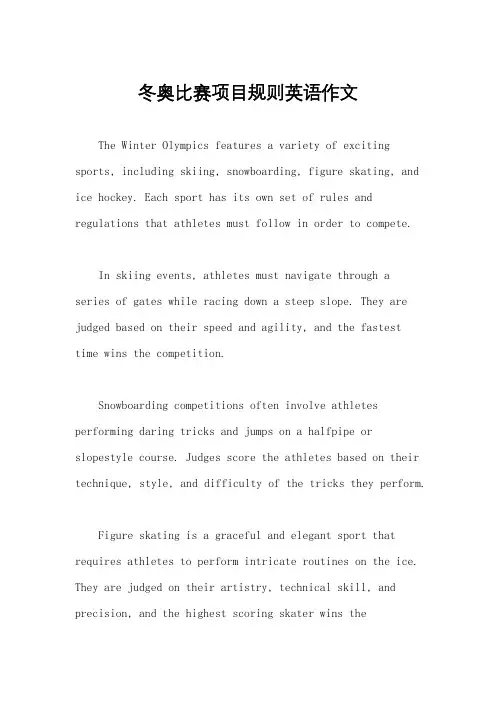
冬奥比赛项目规则英语作文The Winter Olympics features a variety of exciting sports, including skiing, snowboarding, figure skating, and ice hockey. Each sport has its own set of rules and regulations that athletes must follow in order to compete.In skiing events, athletes must navigate through aseries of gates while racing down a steep slope. They are judged based on their speed and agility, and the fastest time wins the competition.Snowboarding competitions often involve athletes performing daring tricks and jumps on a halfpipe or slopestyle course. Judges score the athletes based on their technique, style, and difficulty of the tricks they perform.Figure skating is a graceful and elegant sport that requires athletes to perform intricate routines on the ice. They are judged on their artistry, technical skill, and precision, and the highest scoring skater wins thecompetition.Ice hockey is a fast-paced and physical team sport played on an ice rink. Teams compete to score goals by shooting a puck into the opposing team's net, and the team with the most goals at the end of the game wins.Overall, the Winter Olympics showcases the incredible talent and athleticism of athletes from around the world, and the rules of each sport ensure fair and exciting competition for all involved.。
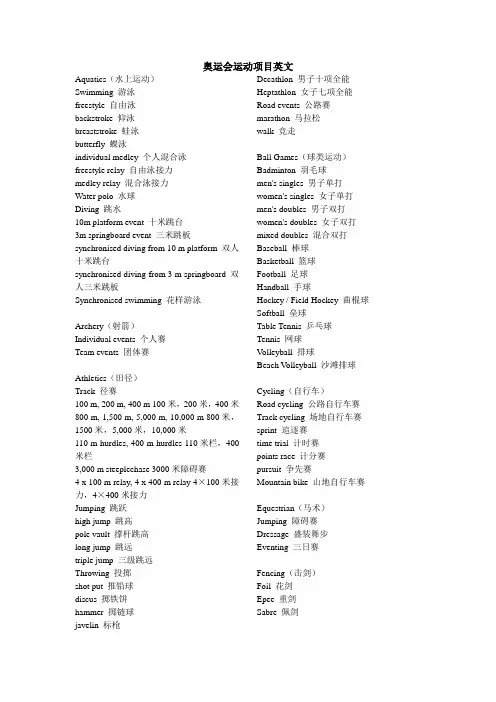
奥运会运动项目英文Aquatics(水上运动)Swimming 游泳freestyle 自由泳backstroke 仰泳breaststroke 蛙泳butterfly 蝶泳individual medley 个人混合泳freestyle relay 自由泳接力medley relay 混合泳接力Water polo 水球Diving 跳水10m platform event 十米跳台3m springboard event 三米跳板synchronised diving from 10 m platform 双人十米跳台synchronised diving from 3 m springboard 双人三米跳板Synchronised swimming 花样游泳Archery(射箭)Individual events 个人赛Team events 团体赛Athletics(田径)Track 径赛100 m, 200 m, 400 m 100米,200米,400米800 m, 1,500 m, 5,000 m, 10,000 m 800米,1500米,5,000米,10,000米110 m hurdles, 400 m hurdles 110米栏,400米栏3,000 m steeplechase 3000米障碍赛4 x 100 m relay, 4 x 400 m relay 4×100米接力,4×400米接力Jumping 跳跃high jump 跳高pole vault 撑杆跳高long jump 跳远triple jump 三级跳远Throwing 投掷shot put 推铅球discus 掷铁饼hammer 掷链球javelin 标枪Decathlon 男子十项全能Heptathlon 女子七项全能Road events 公路赛marathon 马拉松walk 竞走Ball Games(球类运动)Badminton 羽毛球men's singles 男子单打women's singles 女子单打men's doubles 男子双打women's doubles 女子双打mixed doubles 混合双打Baseball 棒球Basketball 篮球Football 足球Handball 手球Hockey / Field Hockey 曲棍球Softball 垒球Table Tennis 乒乓球Tennis 网球V olleyball 排球Beach V olleyball 沙滩排球Cycling(自行车)Road cycling 公路自行车赛Track cycling 场地自行车赛sprint 追逐赛time trial 计时赛points race 计分赛pursuit 争先赛Mountain bike 山地自行车赛Equestrian(马术)Jumping 障碍赛Dressage 盛装舞步Eventing 三日赛Fencing(击剑)Foil 花剑Epee 重剑Sabre 佩剑Gymnastics(体操)Artistic Gymnastics 竞技体操Floor Exercises 自由体操Pommel Horse 鞍马Rings 吊环V ault 跳马Parallel Bars 双杠Horizontal Bar 单杠Uneven Bars 高低杠Balance Beam 平衡木Rhythmic Gymnastics 艺术体操Gymnastics Trampoline 蹦床Modern Pentathlon(现代五项)Shooting 射击Fencing 击剑Swimming 游泳Riding 马术Cross-country running 越野跑Sailing(帆船)Windsurfer men / women - Mistral one design 男子/女子帆板米氏级Single-handed Dinghy Women - Europe 女子帆船欧洲级Single-handed Dinghy men - Finn 男子帆船芬兰人级Single-handed Dinghy open - Laser 激光级Double-handed Dinghy men / women - 470 男子/女子帆船470级预赛Double-handed Dinghy open - 49er 49人级Multihull open - Tornado 龙卷风级Keelboat men - Star 男子星光级Keelboat women - Yngling 女子索林级Shooting(射击)10 m air rifle 10米气步枪10 m air pistol 10米气手枪Men's 10 m running target 男子10米移动靶Men's 50 m rifle prone position 男子50米步枪卧射50 m rifle three positions 50米步枪3种姿势Men's 50 m pistol 男子50米手枪Women's 25 m pistol 女子25米手枪Men's 25 m rapid fire pistol 男子25米手枪速射Trap 多向飞碟Double trap 双多向飞碟Skeet 双向飞碟Triathlon(铁人三项)Swimming 游泳Cycling 自行车Running 跑步Weightlifting(举重)Snatch 抓举Clean and jerk 挺举Wrestling(摔跤)greco-roman 古典式摔跤free style 自由式摔跤Rowing(赛艇)Boxing(拳击)Canoeing(皮划艇)Judo(柔道)Taekwondo(跆拳道)。
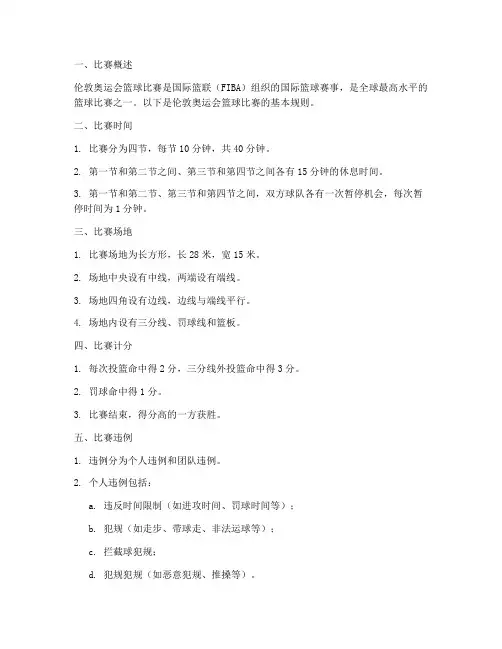
一、比赛概述伦敦奥运会篮球比赛是国际篮联(FIBA)组织的国际篮球赛事,是全球最高水平的篮球比赛之一。
以下是伦敦奥运会篮球比赛的基本规则。
二、比赛时间1. 比赛分为四节,每节10分钟,共40分钟。
2. 第一节和第二节之间、第三节和第四节之间各有15分钟的休息时间。
3. 第一节和第二节、第三节和第四节之间,双方球队各有一次暂停机会,每次暂停时间为1分钟。
三、比赛场地1. 比赛场地为长方形,长28米,宽15米。
2. 场地中央设有中线,两端设有端线。
3. 场地四角设有边线,边线与端线平行。
4. 场地内设有三分线、罚球线和篮板。
四、比赛计分1. 每次投篮命中得2分,三分线外投篮命中得3分。
2. 罚球命中得1分。
3. 比赛结束,得分高的一方获胜。
五、比赛违例1. 违例分为个人违例和团队违例。
2. 个人违例包括:a. 违反时间限制(如进攻时间、罚球时间等);b. 犯规(如走步、带球走、非法运球等);c. 拦截球犯规;d. 犯规犯规(如恶意犯规、推搡等)。
3. 团队违例包括:a. 界外球;b. 比赛开始时,球未在比赛场地上;c. 球出界。
六、比赛犯规1. 犯规分为普通犯规和技术犯规。
2. 普通犯规是指球员在比赛过程中对对方球员的非法接触。
3. 技术犯规是指球员在比赛过程中违反比赛规则,如教练员、裁判员或球队工作人员的犯规。
4. 犯规球员将被警告或被罚下场。
七、比赛暂停1. 每节比赛,每队各有两次暂停机会。
2. 在比赛过程中,教练员、球员或球队工作人员可以向裁判员申请暂停。
八、比赛结束1. 比赛时间到,得分高的一方获胜。
2. 如果比赛结束时双方得分相同,则进行加时赛,加时赛时间为5分钟。
3. 加时赛结束后,仍不分胜负,则继续进行加时赛,直到分出胜负。
九、其他规定1. 比赛中,球员必须穿着统一的比赛服装,包括球衣、短裤和运动鞋。
2. 比赛中,球员不得佩戴任何可能影响比赛或他人安全的物品。
3. 比赛过程中,球员不得进行侮辱性、歧视性或攻击性的言行。
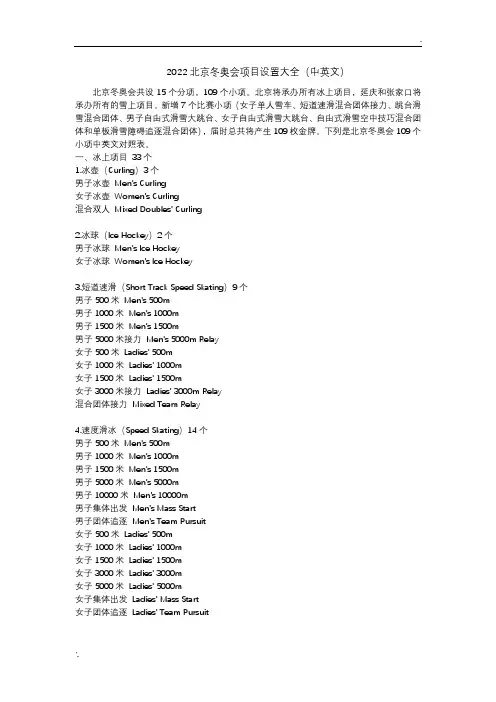
2022北京冬奥会项目设置大全(中英文)北京冬奥会共设15个分项,109个小项。
北京将承办所有冰上项目,延庆和张家口将承办所有的雪上项目。
新增7个比赛小项(女子单人雪车、短道速滑混合团体接力、跳台滑雪混合团体、男子自由式滑雪大跳台、女子自由式滑雪大跳台、自由式滑雪空中技巧混合团体和单板滑雪障碍追逐混合团体),届时总共将产生109枚金牌。
下列是北京冬奥会109个小项中英文对照表。
一、冰上项目33个1.冰壶(Curling)3个男子冰壶Men's Curling女子冰壶Women's Curling混合双人Mixed Doubles' Curling2.冰球(Ice Hockey)2个男子冰球Men's Ice Hockey女子冰球Women's Ice Hockey3.短道速滑(Short Track Speed Skating)9个男子500米Men's 500m男子1000米Men's 1000m男子1500米Men's 1500m男子5000米接力Men's 5000m Relay女子500米Ladies' 500m女子1000米Ladies' 1000m女子1500米Ladies' 1500m女子3000米接力Ladies' 3000m Relay混合团体接力Mixed Team Relay4.速度滑冰(Speed Skating)14个男子500米Men's 500m男子1000米Men's 1000m男子1500米Men's 1500m男子5000米Men's 5000m男子10000米Men's 10000m男子集体出发Men's Mass Start男子团体追逐Men's Team Pursuit女子500米Ladies' 500m女子1000米Ladies' 1000m女子1500米Ladies' 1500m女子3000米Ladies' 3000m女子5000米Ladies' 5000m女子集体出发Ladies' Mass Start女子团体追逐Ladies' Team Pursuit5.花样滑冰(Figure Skating)5个男子单人滑Men's Single Skating女子单人滑Ladies' Single Skating双人滑Pair Skating冰上舞蹈Ice Dance混合团体Mixed Team Event二、雪上项目76个1.自由式滑雪(Freestyle Skiing)13个男子雪上技巧Men's Moguls男子空中技巧Men's Aerials男子障碍追逐Men's Ski Cross男子U型场地技巧Men's Ski Halfpipe男子坡面障碍技巧Men's Ski Slopestyle男子大跳台Men's Big Air女子雪上技巧Ladies' Moguls女子空中技巧Ladies' Aerials女子障碍追逐Ladies' Ski Cross女子U型场地技巧Ladies' Ski Halfpipe女子坡面障碍技巧Ladies' Ski Slopestyle女子大跳台Women's Big Air混合团体空中技巧Mixed Team Aerials2.单板滑雪(Snowboard)11个男子平行大回转Men's Parallel Giant Slalom男子U型场地技巧Men's Halfpipe男子障碍追逐Men's Snowboard Cross男子坡面障碍技巧Men's Slopestyle男子大跳台Men's Big Air女子平行大回转Ladies' Parallel Giant Slalom女子U型场地技巧Ladies' Halfpipe女子障碍追逐Ladies' Snowboard Cross女子坡面障碍技巧Ladies' Slopestyle女子大跳台Ladies' Big Air混合团体障碍追逐Mixed Team Snowboard Cross3.高山滑雪(Alpine Skiing)11个男子滑降Men's Downhill男子超级大回转Men's Super-G男子大回转Men's Giant Slalom男子回转Men's Slalom男子全能Men's Alpine Combined女子滑降Ladies' Downhill女子超级大回转Ladies' Super-G女子大回转Ladies' Giant Slalom女子回转Ladies' Slalom女子全能Ladies' Alpine Combined混合团体赛Alpine Mixed Team Event4.越野滑雪(Cross-Country Skiing)12个男子15公里Men's 15km Free男子双追逐Men's 15km + 15km Skiathlon男子竞速赛Men's Sprint Classic男子团体竞速赛Men's Team Sprint Free男子50公里集体出发Men's 50km Mass Start Classic男子4×10公里接力Men's 4×10km Relay女子10公里Ladies' 10km Free女子双追逐Ladies' 7.5km + 7.5km Skiathlon女子竞速赛Ladies' Sprint Classic女子团体竞速赛Ladies' Team Sprint Free女子30公里集体出发Ladies' 30km Mass Start Classic女子4×5公里接力Ladies' 4×5km Relay5. 冬季两项(Biathlon)11个男子20公里个人Men's 20km Individual男子10公里竞速Men's 10km Sprint男子12.5公里追逐Men's 12.5km Pursuit男子15公里集体出发Men's 15km Mass Start男子4×7.5公里接力Men's 4×7.5km Relay女子15公里个人Women's 15km Individual女子7.5公里竞速Women's 7.5km Sprint女子10公里追逐Women's 10km Pursuit女子12.5公里集体出发Women's 12.5km Mass Start女子4×6公里接力Women's 4×6km Relay女子2×6公里+男子2×7.5公里混合接力2×6km Women+2x7.5km Men Mixed Relay6. 跳台滑雪(Ski Jumping)5个男子个人标准台Men's Normal Hill Individual男子个人大跳台Men's Large Hill Individual男子团体Men's Team女子个人标准台Ladies' Normal Hill Individual混合团体Mixed Team Event7.北欧两项(Nordic Combined)3个男子个人标准台+10公里越野滑雪Men's Individual Gundersen NH+10km Cross-Country Skiing男子个人大跳台+10公里越野滑雪Men's Individual Gundersen LH+10km Cross-Country Skiing男子团体大跳台+4×5公里接力越野滑雪Men's Team Gundersen LH+4×5km Cross-Country Skiing8. 雪车(Bobsleigh)4个男子双人2-man Bobsleigh男子四人4-man Bobsleigh女子单人Women’s Monobob女子双人Women's 2-man Bobsleigh9. 钢架雪车(Skeleton)2个男子单人Men's Single女子单人Women's Single10.雪橇(Luge)4个男子单人Men's Single Luge男子双人Doubles' Luge女子单人Women's Single Luge混合团体接力Mixed Team Relay。
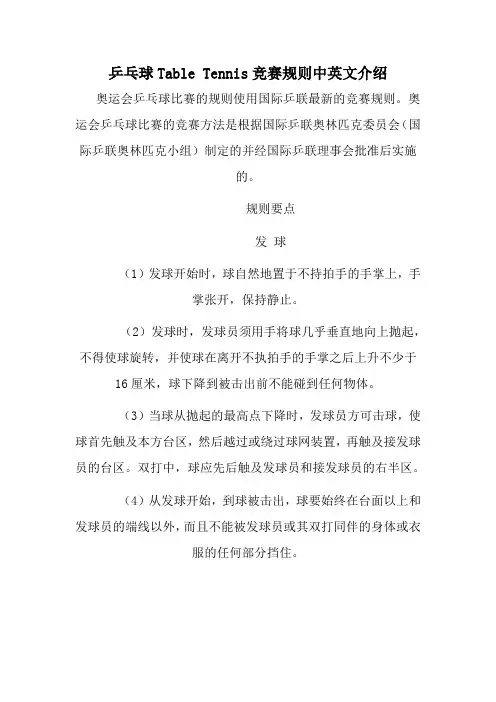
乒乓球Table Tennis竞赛规则中英文介绍奥运会乒乓球比赛的规则使用国际乒联最新的竞赛规则。
奥运会乒乓球比赛的竞赛方法是根据国际乒联奥林匹克委员会(国际乒联奥林匹克小组)制定的并经国际乒联理事会批准后实施的。
规则要点发球(1)发球开始时,球自然地置于不持拍手的手掌上,手掌张开,保持静止。
(2)发球时,发球员须用手将球几乎垂直地向上抛起,不得使球旋转,并使球在离开不执拍手的手掌之后上升不少于16厘米,球下降到被击出前不能碰到任何物体。
(3)当球从抛起的最高点下降时,发球员方可击球,使球首先触及本方台区,然后越过或绕过球网装置,再触及接发球员的台区。
双打中,球应先后触及发球员和接发球员的右半区。
(4)从发球开始,到球被击出,球要始终在台面以上和发球员的端线以外,而且不能被发球员或其双打同伴的身体或衣服的任何部分挡住。
(5)在运动员发球时,球与球拍接触的一瞬间,球与网柱连线所形成的虚拟三角形之内和一定高度的上方不能有任何遮挡物,并且其中一名裁判员要能看清运动员的击球点。
击球对方发球或还击后,本方运动员必须击球,使球直接越过或绕过球网装置,或触及球网装置后,再触及对方台区。
失分(1)未能合法发球;(2)未能合法还击;(3)击球后,该球没有触及对方台区而越过对方端线;(4)阻挡;(5)连击;(6)用不符合规则条款的拍面击球;(7)运动员或运动员穿戴的任何物件使球台移动;(8)运动员或运动员穿戴的任何物件触及球网装置;(9)不执拍手触及比赛台面;(10)双打运动员击球次序错误;(11)执行轮换发球法时,发球一方被接发球一方或其双打同伴,包括接发球一击,完成了13次合法还击。
一局比赛在一局比赛中,先得11分的一方为胜方;10平后,先多得2分的一方为胜方。
一场比赛单打的淘汰赛采用七局四胜制,团体赛中的一场单打或双打采用五局三胜制。
次序和方位(1)在获得2分后,接发球方变为发球方,依此类推,直到该局比赛结束,或直至双方比分为10平,或采用轮换发球法时,发球和接发球次序不变,但每人只轮发1分球。
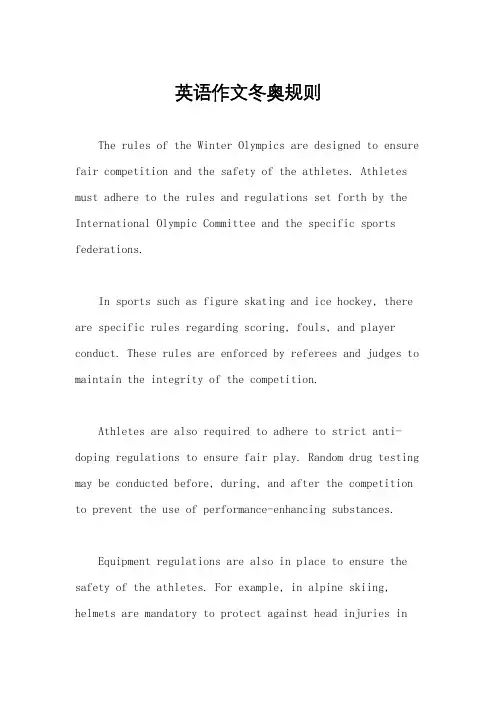
英语作文冬奥规则The rules of the Winter Olympics are designed to ensure fair competition and the safety of the athletes. Athletes must adhere to the rules and regulations set forth by the International Olympic Committee and the specific sports federations.In sports such as figure skating and ice hockey, there are specific rules regarding scoring, fouls, and player conduct. These rules are enforced by referees and judges to maintain the integrity of the competition.Athletes are also required to adhere to strict anti-doping regulations to ensure fair play. Random drug testing may be conducted before, during, and after the competition to prevent the use of performance-enhancing substances.Equipment regulations are also in place to ensure the safety of the athletes. For example, in alpine skiing, helmets are mandatory to protect against head injuries inthe event of a fall.The Winter Olympics also have rules governing athlete eligibility and nationality. Athletes must meet certain criteria to represent their country and may be subject to citizenship and residency requirements.In addition to the rules of competition, there are also guidelines for athlete behavior and sportsmanship. Athletes are expected to conduct themselves with respect and integrity, both on and off the field of play.。
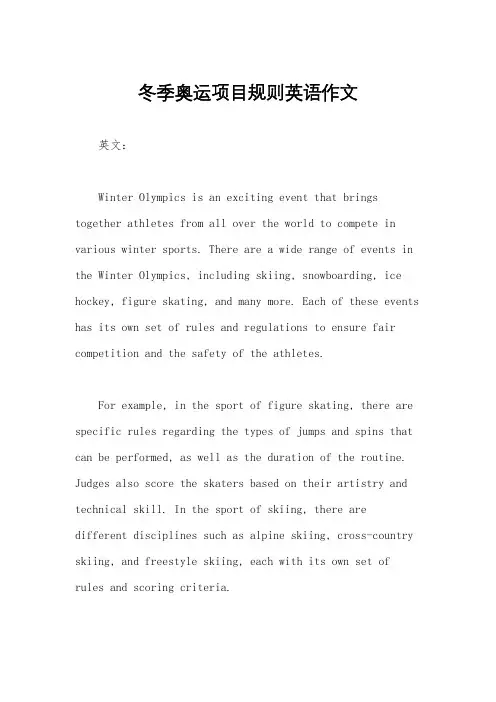
冬季奥运项目规则英语作文英文:Winter Olympics is an exciting event that brings together athletes from all over the world to compete in various winter sports. There are a wide range of events in the Winter Olympics, including skiing, snowboarding, ice hockey, figure skating, and many more. Each of these events has its own set of rules and regulations to ensure fair competition and the safety of the athletes.For example, in the sport of figure skating, there are specific rules regarding the types of jumps and spins that can be performed, as well as the duration of the routine. Judges also score the skaters based on their artistry and technical skill. In the sport of skiing, there aredifferent disciplines such as alpine skiing, cross-country skiing, and freestyle skiing, each with its own set of rules and scoring criteria.One of the most important aspects of the Winter Olympics is the emphasis on sportsmanship and fair play. Athletes are expected to compete with integrity and respect for their fellow competitors. This is reflected in the rules and regulations that govern the conduct of the athletes during the games.In addition, the Winter Olympics also has strict guidelines for the use of performance-enhancing substances. Athletes are regularly tested for doping to ensure a level playing field for all competitors. This is a crucial aspect of the rules and regulations of the Winter Olympics, as it upholds the principles of fair competition and integrity.Overall, the rules and regulations of the Winter Olympics are designed to ensure the safety of the athletes, maintain fair competition, and uphold the values of sportsmanship and integrity.中文:冬季奥运会是一个激动人心的赛事,汇集了来自世界各地的运动员参加各种冬季运动比赛。
冬季奥运项目规则英语作文英文:Winter Olympic Games feature a variety of exciting and challenging sports, each with its own set of rules and regulations. As a sports enthusiast, I find the diverse range of events to be both thrilling and inspiring.One of the most popular winter sports is figure skating, which requires athletes to perform intricate and graceful routines on ice. The rules of figure skating are strict,with judges scoring competitors based on factors such as technical difficulty, artistry, and execution. For example, a skater must execute jumps and spins with precision, while also conveying emotion and storytelling through their performance.Another thrilling event is the alpine skiing competition, where athletes race down steep and treacherous slopes at breakneck speeds. The rules of alpine skiingdictate that competitors must navigate through a series of gates while maintaining control and speed. One famous rule in alpine skiing is the "gate penalty," which adds time to a skier's final score if they miss a gate.Moving on to the bobsleigh event, teams of athletes hurtle down an icy track in a gravity-powered sled. The rules of bobsleigh are focused on teamwork, coordination, and speed. For instance, the start of the race is crucial, as teams must push the sled with maximum force to gain momentum. Additionally, the timing and coordination of the team members are essential for a successful run.In addition to these examples, the Winter Olympic Games also feature sports such as snowboarding, ice hockey, and speed skating, each with its own unique set of rules and regulations.中文:冬季奥运会包含了各种激动人心和具有挑战性的运动项目,每个项目都有其自己的规则和条例。
奥运会高尔夫规则奥运会高尔夫规则高尔夫于1900年、1904年两次进入奥运会,之后100多年销声匿迹。
2009年,在丹麦举行的国际奥委会全会上,高尔夫重返奥运大家庭,成功入选2016年里约奥运会正式比赛项目。
而2014年南京青奥会则成为高尔夫项目100多年来首次亮相奥运赛场的里程碑。
本届奥运会高尔夫比赛将在北京时间8月11日-20日举行。
一、一共金牌2枚男、女个人各1枚。
二、规则高尔夫规则《Rules of Golf》由R&A(圣安德鲁斯皇家古老高尔夫俱乐部)和USGA(美国高尔夫球协会)每四年联合发布一次。
世界上第一个高尔夫运动的规则制定于1744年的爱丁堡高尔夫球友协会,以明文方式公布,共13条。
从1897年开始,R&A就担负着高尔夫规则的维护与修改的责任。
所谓打高尔夫球最基本原则就是将一颗球自球台连续打击至其进洞为止。
即是由第一杆开始,接着第二、第三杆,重复地击球,将球打进洞,除此之外便别无他法。
高尔夫球场应划分为18个大小不一、形状各异的场地,每块场地均由开球台、球道、果岭和球洞组成。
开球台即是开球用的草坪,一般面积30-150平方米,较其周围地表高约0.3-1.0m,表面为修剪过的短草,有一定坚硬度且表面平滑。
果岭为球洞所处的区域,其平面多呈近似圆形或椭圆形的自由形状,表面种植优质草坪,并经修剪和碾压密实,略有缓坡起伏,使球能在场地上无阻碍地滚动。
由开球台到果岭和球洞间为平坦球道,其宽度最小30m,一般为40-50m,植以剪短的草皮。
球道外为粗糙地带。
靠近球道为宽2-3m的轻度粗糙区,即植有剪短的野草,其外侧为重度粗糙区,即为自然草丛或树林等。
在比赛中,每位选手只能携带14支以内的球杆参赛。
男子选手着有衣领和衣袖之高尔夫球恤衫,短裤或长裤(短裤的长度应不高于膝盖以上或以下2英寸),以及系带高尔夫软钉球鞋(须穿袜子)。
女子选手着有衣领和衣袖之高尔夫球恤衫,长裤、裙、或短裙(裙及短裤的长度应不高于膝盖6英寸),以及系带高尔夫软钉球鞋(须穿袜子)。
冬季奥运项目规则英语作文下载温馨提示:该文档是我店铺精心编制而成,希望大家下载以后,能够帮助大家解决实际的问题。
文档下载后可定制随意修改,请根据实际需要进行相应的调整和使用,谢谢!并且,本店铺为大家提供各种各样类型的实用资料,如教育随笔、日记赏析、句子摘抄、古诗大全、经典美文、话题作文、工作总结、词语解析、文案摘录、其他资料等等,如想了解不同资料格式和写法,敬请关注!Download tips: This document is carefully compiled by theeditor. I hope that after you download them,they can help yousolve practical problems. The document can be customized andmodified after downloading,please adjust and use it according toactual needs, thank you!In addition, our shop provides you with various types ofpractical materials,such as educational essays, diaryappreciation,sentence excerpts,ancient poems,classic articles,topic composition,work summary,word parsing,copyexcerpts,other materials and so on,want to know different data formats andwriting methods,please pay attention!The Winter Olympics is a thrilling event that showcases the talent and skill of athletes from around the world. With a wide range of sports and events, each with its own unique rules and regulations, the Winter Olympics offers something for everyone to enjoy.One of the most popular events in the Winter Olympicsis figure skating. This elegant and graceful sport requires athletes to perform a series of jumps, spins, and intricate footwork on the ice. The judges evaluate the skaters based on their technical skills, artistry, and overall performance. It's a sport that demands both athleticism and artistry, and the skaters never fail to captivate the audience with their stunning routines.Another exciting event is snowboarding. Thisadrenaline-pumping sport involves athletes descending down a snow-covered slope while performing tricks and jumps on their snowboards. The judges score the athletes based ontheir difficulty of tricks, execution, and style. It's a sport that combines athleticism, creativity, and risk-taking, and the snowboarders always push the boundaries of what is possible in the sport.Ice hockey is a fast-paced and intense team sport that captivates fans around the world. Two teams compete to score goals by shooting a puck into the opponent's net using their hockey sticks. The rules of ice hockey are complex and include penalties for various infractions. It's a sport that requires teamwork, skill, and physicality, and the players' passion and determination are evident on the ice.Ski jumping is a thrilling event that showcases the bravery and skill of the athletes. Competitors launch themselves off a ramp and soar through the air before landing on the snow below. The judges evaluate the athletes based on the distance jumped and their style in the air.It's a sport that requires precision, technique, and nerves of steel, and the ski jumpers never fail to amaze withtheir incredible feats of athleticism.The Winter Olympics also includes events such as speed skating, bobsleigh, curling, and many more. Each sport has its own unique set of rules and regulations, but they all share a common goal to showcase the talent, dedication, and hard work of the athletes.In conclusion, the Winter Olympics is a thrilling event that offers a wide range of sports and events for everyone to enjoy. From figure skating to snowboarding, ice hockey to ski jumping, each sport has its own unique rules and regulations. The athletes' talent, skill, and determination shine through in every event, making the Winter Olympics a truly unforgettable experience.。
冬季奥运项目规则英语作文Title: Rules of Winter Olympic Events。
The Winter Olympics, held every four years, showcase a plethora of exhilarating sports that test athletes' skills, endurance, and courage amidst icy conditions. These events adhere to strict rules and regulations to ensure fair competition and the safety of participants. Let's delveinto the rules governing some of the prominent Winter Olympic sports:1. Figure Skating:Figure skating combines elements of grace, athleticism, and artistic expression. The rules for figure skating are governed by the International Skating Union (ISU). Each performance is evaluated by a panel of judges based on technical merit and artistic impression. Skaters must adhere to specific elements such as jumps, spins, and footwork sequences outlined in the ISU regulations.Additionally, there are rules regarding costumes, music selections, and choreography to maintain the sport's elegance and integrity.2. Alpine Skiing:Alpine skiing encompasses various disciplines including downhill, slalom, giant slalom, super-G, and combined events. The rules for each discipline are established by the International Ski Federation (FIS). Athletes must navigate through a series of gates placed along a steep, winding course while adhering to specific rules regarding their trajectory and technique. Time penalties are incurred for missing gates or straying from the designated course. Safety measures such as helmet requirements and course inspections are also mandated to minimize risks during competition.3. Snowboarding:Snowboarding has gained popularity since its introduction to the Winter Olympics, offering thrillingperformances and daring maneuvers. The rules for snowboarding events are governed by the International Ski Federation (FIS) and the International Snowboarding Federation (ISF). Competitors showcase their skills in disciplines such as halfpipe, slopestyle, snowboard cross, and parallel giant slalom. Judges assess each run based on factors like amplitude, difficulty of tricks, and overall execution. Rules regarding equipment specifications, course design, and safety protocols ensure fair play and minimize injuries.4. Ice Hockey:Ice hockey is a fast-paced team sport characterized by intense physicality and strategic gameplay. The rules for ice hockey are established by the International Ice Hockey Federation (IIHF). Teams compete to score goals by shooting a puck into the opposing team's net while adhering to rules regarding offside, icing, and penalties for infractions such as slashing and tripping. Referees enforce these rules to maintain order and fairness on the ice. Additionally, equipment regulations and player eligibility criteria areenforced to uphold the integrity of the sport.5. Biathlon:The biathlon combines cross-country skiing and rifle marksmanship, requiring athletes to display proficiency in both disciplines. The rules for biathlon events are governed by the International Biathlon Union (IBU). Competitors ski a designated course with periodic stops at shooting ranges to target a series of circular targets. Penalties are incurred for missed targets, either through added time or additional skiing distance. Athletes must also adhere to equipment regulations and safety protocols while competing in varying weather conditions.In conclusion, the Winter Olympic events encompass a diverse range of sports, each governed by specific rules and regulations established by their respective international federations. These rules ensure fair competition, uphold the integrity of the sports, and prioritize the safety of athletes. Whether it's the grace of figure skating, the speed of alpine skiing, theexcitement of snowboarding, the intensity of ice hockey, or the endurance of biathlon, the Winter Olympics continue to captivate audiences worldwide with their thrilling displays of athleticism and sportsmanship.。
冬奥会赛制英语作文The Winter Olympics Competition Format。
The Winter Olympics is a quadrennial multi-sport event featuring various winter sports, including skiing, skating, ice hockey, and more. The competition format of the Winter Olympics is carefully designed to ensure fairness, excitement, and showcase the skills of the participating athletes. Let's delve into the intricacies of the Winter Olympics competition format across different sports.Skiing Events:Skiing events in the Winter Olympics encompass disciplines such as Alpine skiing, cross-country skiing, freestyle skiing, and ski jumping. Each discipline has its unique competition format tailored to test different aspects of the athletes' abilities.In Alpine skiing, athletes compete in events like thedownhill, slalom, giant slalom, and super-G. These events involve individual runs down a course marked with gates or flags. The fastest time wins, with penalties for missing gates or falls.Cross-country skiing features races of varying lengths, including sprints, individual start races, and mass start races. The competition format often includes qualifiers and heats, leading to exciting finals where athletes display their endurance and technique.Freestyle skiing combines elements of skiing and acrobatics, with events like moguls, aerials, and ski cross. Athletes perform tricks and maneuvers judged on criteria such as difficulty, execution, and amplitude.Ski jumping competitions involve athletes launching themselves off a ramp and trying to achieve the longestjump possible. Judges score based on distance and style,with points deducted for instability or poor form.Skating Events:Figure skating and speed skating are prominent events in the Winter Olympics, each with its distinct competition format.Figure skating includes singles, pairs, and ice dance categories. Athletes perform choreographed routines set to music, showcasing a combination of technical skill, artistry, and expression. Judges score based on elements such as jumps, spins, footwork, and presentation.Speed skating features races of various distances, from the short track to the long track. Athletes compete against each other or the clock, with the fastest time determining the winner. Tactics, endurance, and speed are crucial in these high-speed competitions.Ice Hockey:Ice hockey is a team sport played on ice, with each team aiming to score goals by shooting a puck into the opponent's net. The Winter Olympics ice hockey competitionformat typically includes a preliminary round-robin stage followed by knockout rounds leading to the medal matches.Biathlon:Biathlon combines cross-country skiing and rifle shooting, requiring athletes to exhibit both endurance and precision. Competitors ski a course with shooting rounds at designated targets. Penalties are incurred for missed shots, adding a strategic element to the race.Curling:Curling involves teams sliding stones on a sheet of ice towards a target area, while teammates sweep the ice to control the stone's speed and direction. The WinterOlympics curling competition format includes round-robin matches followed by playoffs to determine the medal winners.Snowboarding:Snowboarding events encompass disciplines such ashalfpipe, slopestyle, and snowboard cross. Athletes perform tricks and maneuvers on snowboards, with judges scoring based on difficulty, execution, and style.Conclusion:The Winter Olympics competition format is diverse and dynamic, reflecting the range of winter sports showcased at the event. From the adrenaline-fueled speed of skiing and skating to the precision of shooting in biathlon, each sport offers its unique challenges and thrills. Through rigorous training, determination, and skill, athletes from around the world come together to compete on the grand stage of the Winter Olympics, embodying the spirit of sportsmanship and excellence.。
奥运体育英语VocabularyUnit 11. Olympic Games 奥运会2. Olympic champion 奥林匹克冠军3. Olympic torch 奥林匹克火炬4. Olympic record 奥林匹克纪录5. Olympic spirit 奥林匹克精神Unit 21. Olympic village 奥运村2. Olympic competition events 奥运会比赛项目3. Olympic mascot 奥运会吉祥物4. Olympic relay 奥运会接力跑5. hosting of the Olympic Games 奥运会举办权Unit 31. Olympic oath 奥运会宣言2. Olympic schedule 奥运会日程安排3. Olympic gold medal 奥运会金牌4. Olympic silver medal 奥运会银牌5. Olympic bronze medal 奥运会铜牌Unit 41. Olympic qualification 奥运会前的预选赛2. eight of finals 八分之一决赛3. four of finals 四分之一决赛4. semi-finals 半决赛5. finals 决赛Unit 51. National Games for the Disabled 全国残疾人运动会2. National City Games 全国城市运动会3. National University Games 全国大学生运动会4. National Workers’ Games 全国工人运动会5. National Minorities Games 全国少数民族运动会Unit 61. opening ceremony 开幕式2. closing ceremony 闭幕式3. host country 东道国4. anthem 会歌5. emblem 会徽6. marching in 入场式7. flame-lighting ceremony 火炬点火仪式Unit 71. playing area 比赛区2. competition rules 比赛规则3. schedule 比赛日程4. competition affairs 比赛事务5. competition arena; ground; court 比赛场地Unit 81. competition regulations 比赛条例2. play hall 比赛厅3. event 比赛项目4. score 比分5. eligibility for competition 比赛资格Unit 91. exhibition match 表演赛2. dual meet 对抗赛3. open game 公开赛4. farewell match 告别赛5. extra match 附加赛Unit 101. championship 锦标赛2. qualifying match 及格赛3. vital match 护级赛4. league match 联赛5. warming-up match 热身赛Unit 111. elimination series 淘汰赛2. championship fight 卫冕赛3. round robin 循环赛4. selective trials 选拔赛5. challenge match 邀请赛Unit 121. No.1 seed 第一号种子选手2. first stage contest 第一阶段比赛3. top-notch player 第一流选手4. first round 第一轮比赛5. first place 第一名Unit 131. dark horse 黑马2. record holder 纪录保持者3. prize winner 获奖选手4. second rater 二流选手5. international player 国际比赛选手Unit 141. referee’s platform 裁判台2. board of referees 裁判委员会3. referee’s chair 裁判椅4. referee 裁判员5. head judge 裁判长Unit 151. record maker 创纪录选手2. setting a record 创造纪录3. creating good results 创造好成绩4. to set a new record 创造新纪录5. breaking a record 打破纪录6. equalizing a record 平纪录7. record beater 破纪录选手Unit 161. bonus 奖金2. medal 奖牌3. trophy 奖品4. trophy cup 奖杯5. pennant 锦旗Unit 171. track sports 竞赛运动2. traditional sports 传统运动3. health sports 健身运动4. mass sports 群众性运动5. ancient sports 古典运动Unit 181. ice sports 冰上运动2. air sports 航空运动3. ball games 球类运动4. water sports 水上运动5. athletics 田径运动Unit 191. car racing and cycling 车类运动2. motorcycling 摩托车运动3. auto-race 汽车运动4. automobile race 赛车运动5. cycling 自行车运动Unit 20 basketball1. dribble 运球2. dribbler’s path 运球路线3. dribble block 运球急停4. illegal dribble 运球违例5. dribble shot 运球投篮Unit 21 volleyball1. server 发球队员2. setter 二传手3. back line player 后排队员4. blocker 拦网队员5. ace spikier 主攻手6. block leader 主拦队员Unit 22 table tennis1. defensive player 防守型选手2. attacking player 攻击型选手3. fast attack player 快攻手4. right-hand player 右手执拍者5. left-hand player 左手执拍者Unit 23 football1. quarters player 出场队员2. midfield link men 中场队员3. front player 锋线队员4. back 后卫5. goalkeeper 守门员Unit 24 track and field1. short-distance race 短跑2. 200-meter dash 200米赛跑3. Marathon race 马拉松赛跑4. cross-country race 越野跑5. middle and long distance race 中长距离跑Unit 25 track and field1. long jump 跳远2. triple jump 三级跳3. high jump 跳高4. pole jump 撑杆跳高5. 110m hurdles 110米栏Unit 26 track and field1. shot 铅球2. javelin 标枪3. hammer 链球4. discus 铁饼5. throw 投掷Unit 27 badminton1. serving side 发球方2. receiving side 接球方3. first server 第一发球员2. second server 第二发球员5. forecourt player 前场队员6. backcourt player 后场队员7. left-court player 左场区队员8. right-court player 右场区队员Unit 28 bowling1. alley bed 保龄球床2. bowling pin 保龄球瓶3. pin fall 被击倒的瓶4. spare 补中5. splash 分瓶Unit 29 golf1. match play 比洞赛2. stroke play 比杆赛3. charity 慈善赛4. master tour 大师赛5. classic event 精英赛Unit 30 shuttlecock1. preparatory posture 准备姿势2. formation 阵容配备3. self-toss and attack 自传自攻4. fair fit 合法击球5. kick with foot-arch 脚正背踢球Unit 31 shooting1. pistol 手枪2. rifle 步枪3. clay-pigeon shooting 飞碟射击4. revolver 左轮手枪5. shooting hall 射击馆Unit 32 diving1. starting position 开始姿势2. action in the air 空中动作3. spoiled dive 没有做好的动作4. required dive 规定动作5. optional dive 自选动作Unit 33 swimming1. free-style 自由泳2. back stroke 仰泳3. breast-stroke 蛙泳4. butterfly stroke 蝶泳5. scissors-crawl stroke 剪式爬泳Unit 34 gymnastics1. pommel horse 鞍马2. horizontal bar 单杠3. rings 吊环4. parallel bars 双杠5. vaulting 跳马Unit 35 gymnastics1. high-low bars 高低杠2. balance beam 平衡木3. free exercises 自由体操4. bounding bed 蹦床5. callisthenic’s 健美操Unit 36 automobile race1. Benetton 贝纳通车队2. Ferrari 法拉利车队3. Toyota 丰田车队4. Subaru 富士车队5. Ford 福特车队SentencesBadminton:1. Love all, play! 零比零,比赛开始!2. Line! 压线!3. Second service! 第二次发球!4. Service over! 换发球!5. Fault! 违例!6. Out! 界外!7. Play a let! 重发!8. You touched the net! 你触网了!9. You invaded your opponent’s court! 你侵入对手场区!10. Fault, receiver. 接球员违例.11. Play must be continuous! 比赛继续进行!12. Play is suspended! 比赛暂停!Basketball:13. Allow a goal! 投中有效!14. Basket counts! 中篮得分!15. Goal not made! 投篮未中!Soccer:16. A foul! 犯规!17. Referee gives red card. 裁判出示红牌.18. Stop pushing! 不许推认.19. The pass is plucked. 传球被抢断.Table tennis:20. Play ball! 比赛开始!21. Ready, serve! 准备, 发球!22. Score! 得分!23. No! 失分!24. Edge ball! 擦边球!25. Double bounce! 两跳!26. Off! 出界!27. Service over! 换发球!28. Touched net! 触网!29. Double hit! 连击!30. Wrong player! 错接球! (双打)Track and Field:31. On your marks, set, go! 各就各位, 预备, 跑!32. False start, you jump the gun! 起跑犯规, 你抢跑了.33. Runners stand at starting line before race. 比赛前, 选手们站在起跑线上. Weightlifting:34. Three white lights. Good lift! 三盏白灯全亮, 试举成功!35. A second movement. Not valid! 两次预蹲, 无效!36. Red lights. No lift! 红灯, 失败!。
奥运比赛规则英文版SailboatWhen sailing meets on water, it is necessary to implement a set of navigation rules that are much more complex than the traffic rules on land. If athletes want to achieve good results, they must be familiar with a 131 page thick competition rules (RRs), a 95 page thick rule case analysis and a 20 page or more level rules. Before the competition, we have to study two other rules -- competition rules and navigation rules. How to use rules to suppress opponents and make profits is an important topic that athletes and coaches need to study. Sailing competition rules mainly include navigation rules, competition implementation rules and protest trial rules. This rule is revised every four years after the Olympic Games. ISAF also issues rule interpretations, including cases issued annually. All cases were revised and printed in accordance with the latest rules.The most common rule of sailing on the starboard side is to give way to the coming wind; The ship in the upwind position should avoid the downwind ship; When encountering a route buoy or obstacle, the ship approaching the object behind shall avoid the ship already approaching the object, and the ship on the outside shall avoid the shipon the inside. The competition implementation rules mainly stipulate the organization and management norms of the competition, such as the method of departure and the method of signal notification. Protest Trial Provisions are a set of adjudication methods to solve disputes or fouls caused by athletes' encounter and collision on water.Sailing venueThe official sailing competition is required to be held on the open sea, which should be 1 ~ 2 kilometers away from the coast. The competition site consists of three buoys forming an equilateral triangle, and the length of each route is no less than 2 ~ 2.5 nautical miles. The starting route and finishing line are connected by two signs, with a width of 100 ~ 200m, which can be increased or decreased according to the number of participating sailboats. Another way to calculate the length of the route is to multiply the number of sailing boats participating in the competition by the length of the boat by 1.25 meters. The starting route and the terminal line shall be parallel, and the 1st mark and the wind direction line shall be perpendicular to each other at an angle of 90 degrees.Competition order of sailing voyageThe competition order of the whole voyage is as follows: after departure, unify the marks 1, 2 and 3, and then circle the marks 1 and 3 to reach the destination; The competition order of shortening the voyage is: after sailing, circle the signs 1, 2 and 3 to reach the destination. The actual distance of sailing competition is divided into three parts: departure, sailing and destination. The full range is 18000 meters and the shortened range is 10000.events and soring of yatchingSailing events include triangular mark circling and long-distance sailing. The Olympic Games, the world sailing Championships and the China sailing Championships all use short-distance triangular sailing around the mark. The straight-line range is about 28 kilometers. There are 7 competitions in total, and the best results of 6 of them are selected to calculate the ranking of each sailing boat. The results are evaluated according to the sum of the good ranking scores of each competition. Sailboats that have not been disqualified or closed outside the finish line. The scores of each ranking in each race are: 0 points for the first place, 3 points for the second place, 5.7 points for the third place, 8 points for the fourth place, 10 points for the fifth place, 11.7points for the sixth place, the number of ranking times for the seventh place and later places plus 6. If the sailboat has reached the finish line, if it is disqualified or closed outside the finish line due to a foul, its ranking score is Gabe, the total number of sailboats participating in the competition. The sum of the ranking scores of each sailing ship in each race is the result of the ship. The one with less total score is the winner.Sailing race rush foulOne of the rules of sailing competition. It refers to "rush to sail" when the hull, equipment or any part of the crew's body touches the starting route or its extension line before the departure signal is sent. Penalty: the gun pilot returns to the side of the starting route and starts again.Sailing race reliefOne of the rules of sailing competition. Refers to the punishment received by the violator in the game. If the mark is touched or not circled; T ouch another ship, rotate 720 degrees or increase the ranking by 200 / 0.Sailing rulesAfter the departure signal is sent, any part of the racing ship's body, crew or equipment touches the route when it leads to the first subject course, which is regarded as "departure".end a contestTerms used in sailing rules. When the hull, equipment or any part of the athlete's body of the participating yacht bypasses all the specified marks and touches the finish line on the specified race voyage, the yacht will end the race.mark of yachtingA marker showing the course of a race. A flag or flagpole made of metal or foam plastics. The rules stipulate that during the race, the sailboat must bypass or pass through any sign from the specified side.avoid or yachtingOne of the rules of sailing competition. The rules stipulate varioussignals and avoidance rules during the competition to avoid collision and accidents. The sailing ships in the competition must abide by them together. One of them is fair sailing. We must win with superb technology and superior speed. We are not allowed to win by improper means. The navigation rules also stipulate the voyage and the direction of turning around the mark. All sailboats must turn around the mark according to the regulations, otherwise they will be treated as not completing the race. If it collides with the mark, it will be fined 360 degrees, and then continue to participate in the competition; If the sailboat violates the rules in the race, it will be punished to rotate 720 degrees continuously in the same direction (i.e. rotate twice in the same place) to free itself, and then continue to participate in the race.judse boat of yachingFacilities used for organization and command in sailing competitions. The international flag is used to transmit commands. "Red flag" means that the racing sailing boat must bypass the specified signs in a clockwise direction; "Green flag" means that the sailboat must bypass the sign in a counterclockwise direction. When the flag of a certain level is raised on the cross mast, it indicates the warning signal of that level. There are 10 minutes before departure. The "P" flagindicates that there are 5 minutes before departure. After that, every 1 minute, notify each sailboat with audio signals in the order of 4, 3, 2 and L. Before opening the starting route, those who rush through the starting route shall be recalled and set sail again according to the theory of rush to sail. If there are many sailing boats rushing to sail and the referee is unable to identify the sailing boats rushing to sail, all sailing boats of this level will be recalled and set sail again. Sailboats must abide by the competition rules and navigation rules from the start of signal preparation in five minutes.Precautions for sailing competitionSailing competitions are held on the sea, and the sea situation is more complex. Sailing athletes are first required to be able to swim and swim a long distance. In addition, we must have good physical quality and endurance to adapt to the turbulence of long-term sea storms. International sailing competitions are often held in strong winds with a wind speed of 10 ~ 12 meters per second. It is necessary to maintain the course and a certain speed without capsizing. Therefore, athletes need to try their best to press the side and maintain the balance of the ship. At the same time, we should have a clear mind to grasp the surrounding environment, water flow rate, flow direction and air flowchanges; When there are many participating ships, you must also be familiar with the competition rules and avoid fouls. Excellent athletes must also know how to check and sort out the equipment on board, especially adjust the sail type to suit the maximum lift.AthleticsIn track and field games, all races (including hurdles and relay race) belong to track events. The ranking of participants is determined by the order in which their torso (different from head, neck, arms, legs, hands or feet) reaches the vertical line on the inside of the finish line. If the same track results affect the entry of the next race, they shall be recorded if circumstances permit, otherwise they shall be re competed. If the result is the first in the final, the chief referee has the right to decide whether to replay. If he thinks it is not necessary to replay, he will maintain the result; As for the second round, there is no need to repeat it.Beach VolleyballBeach volleyball competition rules the two person beach volleyball competition organized by the International Volleyball Federation isdifferent from the indoor volleyball competition rules:(1)A team consists of two players. Two members of each team must always be on the court without replacement. When the server hits the ball, except for the members of the service team, the players of both sides must be in the field and can stand at will. There is no fixed position, no position error or rotation error, but there is a wrong service order. When each team serves for the first time in a game, the recorder shall reveal the service order. During the game, the announcer shall display the number plate of the server No. 1 or No. 2 to indicate the service order of the team. If the recorder finds that the service order is wrong, he shall notify the referee immediately after serving and hitting the ball.(2)Each team can hit the ball up to three times, and the blocking tentacle can also hit the ball once. For the third time, the ball must be hit back from the net to the opponent's field.(3)Players shall not use their fingers to command the ball to complete offensive hitting.(4)When a player completes an offensive stroke by passing theball with his upper hand, the passing track is not perpendicular to the connecting line of his shoulders, that is, a foul.(5)When defending a heavy spike with an upper hand pass, the ball is allowed to stagnate briefly in the hand. When both players touch the ball online at the same time, they can "hold the ball".(6)Players are allowed to penetrate into the opponent's space, field area and barrier free area without hindering the opponent's competition.(7)Any player can attack the ball at any height in the space of the field.(8)In each game, each team can request a maximum of 4 pauses, each of which is 30 seconds. Any team member can request a suspension from the referee.(9)In any form of competition, when the score of both sides is 5, the recorder will notify the referee, and then the two sides will exchange fields. The team can be given up to 30 seconds of rest in the exchange area. However, there is no break time when the decisive game of thethree game two win system is exchanged.(10)In a three game two win game, all inter game breaks are 5 minutes.(11)If a player is injured during the game, he can be given a recovery time of 5 minutes, but the same player can be given a recovery time of up to two times in a game. If a player does not recover within 5 minutes or the same player recovers more than twice in a game, the team will be declared incomplete.The trial scoring system for each ball is: two wins in three games, 21 points in each game. The team that wins the opponent's 2 points or more is the winning team, and there is no upper limit on the score; If there are 1-1 innings, the third game will be played. The third set is 15 points. The team that wins the opponent's 2 points or more is the winning team of the game, and there is no upper limit on the score; In the first two games, when the scores of both sides add up to 10 points, exchange the playing field. In the third game, when the scores of both sides add up to 5 points, the playing field is changed. There is no rest during each venue exchange, and no delay is allowed.In each game, each team has two pauses, each time for 30 seconds; The inter office rest time is 1 minute; In each game, the penalties of the sports team are not accumulated, but accumulated in each game. At the beginning of each game, the number of penalties imposed by the game shall be recalculated; In each game, each athlete has only one injury suspension; The loser in the draw of the first game has the right to choose first at the beginning of the second game. In case of the third game, draw lots again.BoxingOnly men's boxing is played in the Olympic Games. The boxing match is played by two players on a square boxing ring. In amateur boxing, the goal of the competition is to gain points by hitting the opponent or make the opponent unable to continue the competition.Boxers must wear boxing gloves and are only allowed to hit the side and front parts above the waist with a clenched fist. In the Sydney Olympic Games, each boxing match consists of four rounds, two minutes per round and one minute rest between rounds. The previous Olympic boxing matches had three rounds of three minutes each, but medical reports showed that the new competition system could reducethe physical injury suffered by boxers in the competition.scoreWhen the bell rang, a round of boxing began. The boxers approached each other in an attempt to score an effective blow. A clear and powerful hit to a reasonable part of the opponent's body with the peak part of the clenched glove will score one point. The effective hitting parts include the front and side of the opponent's head and the front and side of the upper body above the waist. The hit on the arm is invalid. If the hit of the effective hit part is determined not to constitute the strike force, no score will be given.A five member panel of judges will decide whether to score a hit, and the electronic scoring system will ensure that the score is scored only when at least three of the five judges decide to score. There are two buttons in front of each judge. One button represents a contestant. When the judge thinks that the competitor has an effective hit on the opponent, he can press the corresponding button. Only when at least three judges press the same button within less than a second of each other will the scoring system score.A boxer can get one point for an effective hit, and the points are calculated by the electronic system. When two boxers hit each other quickly and continuously in a close fight, neither side can hit with enough hitting power. At this time, the judge can wait until the close combat is over and give the dominant party a point.At the end of the boxing match, sum up the points given by each judge. The one who obtains the more points assessed by most judges is declared the winner. If the final points obtained by the two players are the same, the judge will determine the ownership of the winner by evaluating which player is dominant in the competition scene or has a better sports style. If the judges' evaluation is still flat after measuring these factors, they can turn to the defensive skills of the players to make the final evaluation.(strike) fall to the ground and (strike) fall to the groundIn a boxing match, a boxer can be judged as falling to the ground when any other part of his body above the hind foot touches the table. After being hit, the player shall be judged as falling to the ground when his body part falls out of the rope, or he is out of strength, relies on or hangs on the rope, or after being hit hard, although he can stand, he isconsidered unable to continue the competition by the referee on the stage. When the boxer is knocked down, the referee starts counting from 1 to 10 seconds. Electronic counting devices are now used. Each time the device will give a beep, but the judges on the stage often count the seconds themselves. The referee on the stage asked to keep one hand in front of the fallen player for a few seconds and indicate the number of seconds with a gesture. After counting to 10 seconds, if the fallen player cannot stand up, the other party can be judged to knock down the opponent and win.Even if the fallen player stands up immediately, he cannot continue the game. He must first accept the 8 times and seconds of the referee on the stage. After a few seconds to 8, the referee on the stage will order "start" to continue the game when he thinks the game can continue. If the knocked down player falls to the ground again without hitting after standing up, the referee on the stage starts 8 seconds at a time.A player who falls to the ground and is being counted for several seconds can be stopped for several seconds only when the bell rings at the end of the last round of the final to avoid being judged as a failure. In other rounds and competitions, the referee on the stage continuesfor several seconds after the bell ringsIf both sides are knocked to the ground at the same time, the referee on the stage shall count seconds at the same time. As long as one side remains on the ground, continue to count for 10 seconds. If both sides can't stand up from a few seconds to 10 o'clock, the game is over and the one who has obtained the most points before the time of falling to the ground wins.foulWhen a boxer commits a foul, he will face warning, warning or the most severe punishment and be disqualified from the competition. For the same kind of crime, two warnings are equal to one warning. Three warnings, whether for the same foul or not, will result in disqualification of the player. Common fouls include: hitting the other party below the waist line, holding the other party, squeezing the other party's face with arms and elbows, pressing the other party's head out of the rope, opening the palm, hitting with the back of the palm, hitting the back of the other party's head and neck and the back of the body. Other fouls include passive defense, not taking a step back when the referee ordered to "separate", language colliding with the referee on the stageand hitting the other party on the horse after the referee ordered to "separate".。